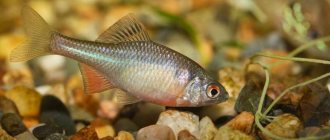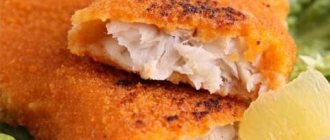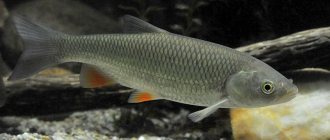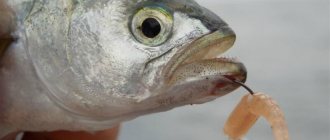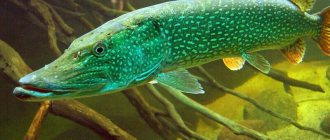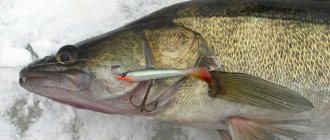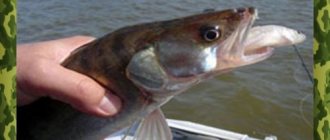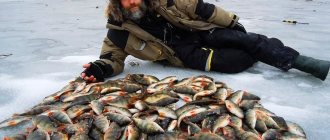Bersch (lat. Stizostedion volgensis), like all representatives of the Perch family, is carnivorous and gathers in schools. Otherwise, it is also called Volga pike perch. Fishermen really like bersh: it is beautiful, its meat is quite tasty, suitable for frying, boiling and fish soup. This fish is not caught for industrial purposes, and fishermen rarely hunt for it purposefully, but it is considered a valuable trophy. Before you start catching false pike perch, make sure that it is not prohibited in your region - after all, bersh is a species included in the Red Book.
Bersch (lat. Stizostedion volgensis), like all representatives of the Perch family, is carnivorous and gathers in schools
Description of the fish
In appearance, the bersh immediately resembles both pike perch and perch. It has a long body, densely covered with small scales. It stands out for its large eyes and the presence of a small hump. There are dark stripes on the body of the fish. The fins are quite large, the two front ones consist of bony spines connected by a membrane.
The fish is found only in Russia. Loves clean bodies of water with moderate currents and a bottom made of pebbles, sand or stones. It is found in small quantities in rivers that flow into the Azov, Caspian and Black Seas, and in reservoirs such as Tsimlyanskoye, Kuibyshevskoye and Volgogradskoye. The predator is most common on the Volga. They usually live in rivers for no more than 6 years.
This fish is usually found in fresh water, but is also found in the sea, although it never goes out into the open sea.
Individuals reach sexual maturity in the 4th year of their life. Spawns in spring, when the water warms up to +10°C. Females choose places up to 2 m deep and lay small yellow eggs in nests. The eggs are less than 1 mm in size. Their number is approximately 300,000. The males then guard the eggs from predators. After 5 days the larvae appear. At first, the larvae feed on the remains of the gall sac, then they move on to plankton and algae.
We also recommend reading:
How do a spinning rod and a float rod differ? Black Hall fishing rods - a high-quality budget version of a spinning rod Making a bombard for fishing with your own hands Do-it-yourself tackle for carp
Common pike perch
The differences between pike perch and bass are important for any angler. Only by thoroughly studying the habits of two predators can you successfully catch one or another fish. There is much more information about pike perch.
On the Don and the coast of the Azov Sea, people call it sula. Knowing the habits of pike perch, you can choose the right feeding, tackle, bait and place for fishing. The result is a rich catch and a good mood.
The range of the common pike perch is quite wide. It can be caught in rivers flowing into seas and lakes such as:
- Baltic.
- Caspian.
- Azovskoe.
- Aral.
- Black.
- Issyk-Kul.
- Balkhash.
- other bodies of water.
This fish is quite large. There is evidence of catches of individuals more than a meter long and weighing 15 kg. It is quite possible that even larger specimens exist.
A characteristic feature of this fish is the presence of fang-shaped teeth, giving it a ferocious appearance. Females look more modest, their fangs are shorter than those of males.
Appearance
There are several varieties of this fish, differing in the color of their scales and the shape of their fins. All of them have an elongated fusiform body, laterally compressed. The scales are small, with uneven jagged edges and sit firmly in the skin. The scaly cover covers part of the head and tail. The lateral line extends onto the caudal fin. There are two fins on the back, they are either separated by a short distance or touch each other.
In one dorsal fin, which is closer to the head, all the rays are hard and spiny. In another - only 1-3, the rest are soft. The same “spines” are present in the anal fin and two ventral fins. The membranes of the fins on the back and tail are dotted with small spots of dark color.
The jaws are elongated, the teeth are sharp and small. The mouth is large and has fangs. There are hard spines on the gill bones.
The back is greenish-gray, darker closer to the fins. The belly is white or gray. Transverse stripes are clearly visible on the sides. They are brown-black, up to 10 or more pieces.
Lifestyle
Pike perch is a predator. The diet mainly consists of small fish. The fry do not disdain invertebrates, eating them in unlimited quantities.
It is practically not found in swampy and muddy waters, as it is very sensitive to a lack of oxygen.
In summer, in hot weather, it stays at a depth of 2-5 meters. Active both day and night. Reflectors located behind the retina of the eyes help in night hunting - so that there is enough moonlight to see clearly.
Night hunting takes place in shallow water or at the very surface of the water, and characteristic splashes can be observed. During the day it goes deeper.
Prefers a sandy and pebble bottom with large driftwood, debris and stones. He ambushes them and then rushes to prey.
It spawns in the spring, when the water temperature is above 12 degrees, usually in April-May. It lays its eggs in shallow water, in places where there is a lot of driftwood and other debris. The caviar is yellowish in color, small. It begins to spawn upon reaching the age of 3-4 years.
Pike perch is highly valued as a commercial fish , so its catch is limited in some countries.
Gallery: berche fish (25 photos)
Description
Bersha cannot be classified as a large freshwater predator, since its maximum weight rarely exceeds 2 kg. The length of the predator can reach 50 cm. The prey of amateur fishermen is usually individuals weighing no more than 1 kg. Like other representatives of the perch family, bersh leads a gregarious lifestyle. Only the largest individuals can be found alone.
This fish is characterized by a rather bright color, in which dark transverse stripes are especially prominent. The sides of the predator are golden in color with a grayish tint. Green tones predominate in the upper part of the body. The belly is white. The cycloid scales of the bersh have a rather dense structure and reliably protect it from various external influences. The cycloid scales that cover not only its body, but also the gill covers, are much larger than those of perch and pike perch. All the bersh's fins are well developed, which makes it a typical predator capable of actively pursuing its prey.
An external description of the bersh would be incomplete without mentioning its large, bulging eyes. Large visual organs have increased light sensitivity, which allows the predator to hunt at considerable depths, where illumination is at a very low level. The bersh's mouth is studded with many small teeth that can reliably hold caught prey.
Bersh and pike perch
Externally, bersh is very similar to pike perch. They belong to the same family and are often found together. Even experienced fishermen can easily confuse them. Some are even sure that these are the same fish.
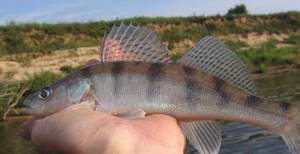
Externally, bersh is very similar to pike perch
Features
Fish differ in their weight. Bersch rarely reaches a weight of 1.2 kg. More often you come across fish about 30 cm long and weighing 400 g. During the first year of life, the Volga pike perch reaches a size of about 8 cm.
The depth that the fish prefers may also differ. Pike perch usually stays at 10 m. An adult bersh goes at least 14 m. Juveniles wash ashore, but also live near the bottom. It happens that small bershik is found in a school of pike perch.
Unlike pike perch, bersh's teeth are small and there are no sharp fangs.

The color of pike perch is less bright. The black stripes of the bersh stand out more clearly. The back has a greenish tint, and the sides and belly are gray. On the gill covers you can see small scales that are whiter than on the body. The head is shorter and wider than that of pike perch, and has a blunt shape. The scales are larger. The fins touch on the back. The lateral line is shorter. The eyes are slightly larger.
Bersch fish. The difference between bersh and pike perch.
Some fishermen mistakenly believe that the bersh is a kind of hybrid that originated from the crossing of perch and pike perch, citing the fact that the color of the bersh is similar to the pike perch, and its medium-sized size and more rounded, knitted shape are just the legacy of the perch genes. In fact, this is a separate species of predator of the perch family, which, according to ichthyologists, is the progenitor of pike perch, and not vice versa.
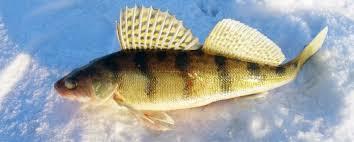
Bersh is a freshwater fish leading a bottom-dwelling lifestyle, whose habitat is limited to the rivers of the Caspian and Black Sea basins. Although recently reports began to appear that this predator was caught in Kazakhstan on the Irtysh and Bukhtarma rivers, there was no official confirmation of these facts.
Its largest population is in the waters of the Middle Volga, for which the predator in these parts received the name “Volga pike perch.” Despite the great similarity in color, structure and behavior, there are plenty of differences between pike perch and bersh. Small individuals can still be confused, but the older the fish, the more clearly the signs of each species are visible.
The first thing that catches your eye when catching a bersh is the absence of fangs.
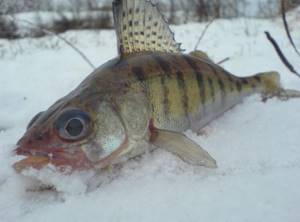
, which pike perch have from birth.
In the mouth of a bersha, all the teeth are small and approximately the same size. In addition, the stripes on his body are better visible and have pronounced, more regular shapes.
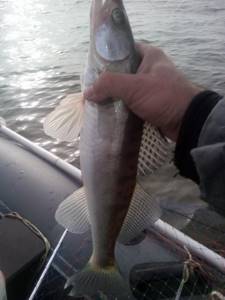
With the same size of fish, the muzzle of the bersh is wider and blunter (shorter), the eyes are much larger, and the scales of the bersh are larger than those of pike perch. Moreover, this fish cannot boast of size. The maximum weight of bersh does not exceed two kilograms, while pike perch, under good circumstances, can grow up to fifteen.
In some regions, the population of this predator is negligible, so commercial catching of bersh is prohibited there and the fish is listed in the Red Book.
As already noted, the behavior of pike perch and bersh is practically the same in terms of lifestyle. They live and hunt in the same territories, and when fishing for pike perch, bersh are often caught. The predator, like pike perch, forms large schools, makes spring (March-April) and autumn migrations (September-October), loves clean, well-oxygenated water, and hard ground. The reasons for the small number of bersh are trivial - pollution of water bodies and siltation of rivers (spawning grounds).
In gastronomic terms, bersh has tender white meat with a minimum number of bones, which makes it universal for preparing any dishes.
Due to its small numbers, targeted fishing for bersh is not carried out at this time.
Fishing Features
You can use different fishing gear:
- spinning rods;
- donks;
- girders;
- float rods.
Wobblers and jig heads are effective. Sometimes shiny drop-shaped jigs are used. Most often they use spinning fishing from a boat or shore.
If the choice fell on a float rod, then make sure that the tackle is strong. Keep your bait near the bottom.
Bersha is actively caught with lures, using narrow double-sided perch spoons of light colors. Spoons are moved in two ways. The first is that the spoon is alternately raised and then lowered to the bottom. The second method is attractive because the raised spoon is lowered into the water to the end, and then pulled along the bottom. If there is no spoon, then a jig head will do instead.

In weak currents, use a large jig with a large hook. To do this, take a fishing line with a diameter of 0.2 mm and a light weight. Bersh is frightened by sharp jerks, so perform smooth movements with small twitches of the tackle.
Since this fish lives in schools, it is good to use an echo sounder to detect its concentrations.
It is more difficult to catch fish in winter because they are not looking for food. Then you should use fishing rods with an inertial reel and fish in deep places and under snags. Sometimes a pike rig helps. Installation occurs as follows: the sinker is lowered to the bottom, which helps the baitfish stay quite deep, thereby attracting prey.
Fish winter in deep places. To find its parking place, you need to actively move and drill many holes. However, you can choose a specific place and wait there. Any of these tactics has a right to exist.
Bersh or Volga pike perch
A small fish, similar in appearance to pike perch, up to 45 cm long. The average weight of an adult is 1.2-1.4 kg.
It is believed that bersh is a purely Russian fish . This is due to the fact that it is found only in Russia and the CIS, in the rivers of the Caspian and Black Seas. There is no other reliable evidence.
There is very little information about this predator. They are mainly drawn from the stories of fishermen who encounter bersha in one place or another. Due to its similarity with pike perch, it is often mistaken for juveniles of this fish, although there are quite a few differences.
Distinctive features
Despite its external resemblance to pike perch, this fish is closer to perch. At one time it was even believed that it was a cross between two fish. How does bersh differ from pike perch:
- shorter and wider snout;
- large eye size;
- teeth of the same size, without fangs;
- scaly cheeks;
- larger scales and smaller rows of them;
- fewer transverse stripes - 8 of them;
- more regular and clear stripes.
All these differences are clearly visible.
This fish is not found in large quantities anywhere. Most often it is caught in the Volga, but only in some places. This is mainly the section of the river below Rybinsk - the bersh does not rise higher upstream.
There is information that it is caught in Belozerye, in the Ural and Sheksna rivers, in the Caspian and Baltic bays. They are quite confusing and contradictory. Nobody knows the exact habitats. This fish has generally been little studied, perhaps due to its similarity to pike perch.
Found in deep places with sandy or rocky muddy bottoms and currents. It was not found in lakes with stagnant water. And just like pike perch, it prefers water saturated with oxygen.
The diet is similar to the diet of pike perch - small fish and invertebrates. It has all the habits of a predatory fish. Keeps in packs.
It spawns later than pike perch, at the same time as bream. The fry swim near the shore, where it is easier to find food.
Lures for fishing
Most of all, fish love silicone baits, which are most similar to live ones. But it’s better to take all the types of colored baits that are available with you when fishing. Twisters, vibrating tails and even foam fish are used. It is better to hide the hook, for example, with wool.
The size of the bait should be no more than 8 cm.
The fish bite on brown, green and yellow colors. At night, he is attracted to very bright or luminous objects.
Bersh is often confused with pike perch, therefore, having understood the intricacies of its appearance and fishing features, you can show off your knowledge and catch to your friends.
Methods of catching bersh
Fishermen do not specifically catch this fish , but for fishing enthusiasts it is a desirable prey.
- In summer, this predator is almost never caught; it is hunted in winter, autumn or early spring.
- They are caught in the current from ice or from a boat.
- The diameter of the fishing line should be no more than 0.2 mm. A thin line will get tangled, and a thick line will float in the current.
- It is better to use large elongated jigs for fishing.
- Sprat or verkhovka is used as a bait.
Nutritional value and benefits of pike perch
The excellent nutritional value of pike perch is due to the wide range of nutrients contained in the meat. Meat products contain about 20 amino acids, including the most essential substances for the human body.
Pike perch meat is considered a real record holder for the content of protein, amino acids and cobalt . As for the beneficial properties, they directly depend on the nutritional composition.
It is no secret that the basis of protein molecules (the main building material for all tissues of the human body) are individual amino acids. They are present in large quantities in pike perch meat, so regular consumption of such fish products helps improve immunity and the effective production of hormones and digestive enzymes.
These substances are essential for various diseases and circumstances, including:
- Severe physical, mental or emotional stress.
- After complex illnesses (as a preventive, therapeutic and restorative agent).
- During the period of active growth of the child’s body.
- During pregnancy and breastfeeding.
Many athletes consume pike perch meat, which is rich in protein , to build muscle mass. In turn, it helps overweight people lose excess weight and restore body elasticity.
In terms of the amount of cobalt, pike perch is considered a food leader. But this element has a positive effect on the processes of hematopoiesis, the breakdown of carbohydrates, proteins and fats, as well as on the synthesis of amino acids. It also absorbs iron and changes hemoglobin levels for the better . Cobalt is indispensable for the following problems:
- Anemia and anemia.
- In case of metabolic disorders.
- For diseases of the gastrointestinal tract.
- Increased nervous excitability.
- Chronic fatigue.
- When the functions of the immune system deteriorate.
- For diseases of the thyroid gland.
The rich content of fluorine and phosphorus has a positive effect on the condition of teeth . Together, these elements regulate neuromuscular activity, strengthen the walls of blood vessels and lower cholesterol levels, effectively preventing the development of heart disease.
How to distinguish pike perch from bersh
The difference between pike perch and bersh lies not only in appearance. Fish also have different habitats and spawning periods. There are also peculiarities in catching “relatives”.
External signs
Comparing the two fish in detail, it is easy to notice the difference in appearance:
- unlike pike perch, bershik does not reach trophy sizes - the maximum body length of this fish is 45 cm, and its weight is 1.4 kg;
- pike perch have sharp, large fangs on the lower and upper jaws. Its Volga counterpart does not have them - its mouth is studded with small sharp teeth of the same length.
- the gill cover and cheeks of bershas are covered with small scales;
- Volga pike perch has a more rounded, larger head with a wide snout and larger eyes;
- the body is covered with 75 rows of large scales;
- the younger brother differs from the fanged one in having a lighter body color with clearly visible transverse black stripes. It also has a darker back.
On a note! In poor lighting, you can distinguish the bersh from its ordinary brother in the following way - just carefully run your finger along the gill cover and cheeks of the caught fish. If at the same time you feel as if your finger is sliding along fine sandpaper, it means that you have caught a bershik.
The method is based on the presence of small scales on the cheeks and gill cover of this fish. It is about them that the finger clings.
Habitat
Although these two species are often found in the same bodies of water, their habitats are slightly different:
- Bershis live in the rivers of the Azov, Black, and Caspian seas. Unlike pike perch, these fish prefer warmer waters. The main population lives in the middle and lower reaches of the Volga. There is a lot of this river predator in the mouth of the great Russian river.
- Pike perch, unlike its Volga counterpart, is more hardy and less demanding on water temperature. It is widespread not only in the southern regions of Russia, but also in reservoirs of Siberia and the Far East.
Within the same reservoir, the habitats of these species are very similar. They are attracted to river holes, whirlpools, and channel ditches of reaches with a depth of 4-5 to 20-25 m. Small bershi very often live together with medium and large perch. Especially in thickets of aquatic vegetation or coastal snags.
Note! Unlike pike perch, bersh is found in coastal desalinated areas of the Caspian and Black Seas. Also, this species is less common in bodies of water with standing water.
Spawning
These two species also differ in terms of spawning:
- pike perch spawns from early April to mid-May at water temperatures above +10 0 C;
- Bersha spawning occurs a little later, from mid-April to mid-May.
Their spawning places are the same - areas with weak currents, clay or pebble bottom. At the same time, the Volga pike perch has an undeveloped parental instinct: after spawning, the male does not guard the clutch of eggs.
Fishing Features
The differences in fishing methods for these two species are not as significant as in appearance, habitat and timing of spawning:
- Common pike perch is caught in holes and pools using spinning rods and mugs. For spinning fishing for fanged lures, artificial baits such as heavy oscillating spoons, twisters, vibrating tails made of edible silicone, and diving minnow-class wobblers are used. For mug fishing, juveniles of narrow-bodied fish species - bleak, perch, roach, gudgeon, dace - are used as live bait.
- In bersh fishing, in addition to spinning rods, circles and girders, they often use a live bait float rod and bottom tackle. Small bershik can also be caught on a regular fishing rod with a large dung worm.
In winter, both species can be caught well with vertical spoons, balance beams and girders.
Description of the species
Almost all perciformes prefer to hunt their own kind (roach, gudgeon, crucian carp, sabrefish, juvenile carp and bream) and do this with great passion, determination and patience. This can be either an active search for a victim or waiting for her for many hours in an ambush-shelter. And if, when looking at a perch, doubts may still arise whether it is a predator or not, then the appearance of the pike perch clearly indicates its carnivorous nature:
- an elongated flat head with several rows of sharp teeth;
- large, closely spaced fangs;
- elongated muscular body, laterally compressed;
- the line of the mouth shifted beyond the far border of the eyes for a wide opening of the jaws;
- 80-90 rows of small dense scales of the ctenoid type (with a prickly ridge of spines along the edges);
- anterior dorsal fin with hard rays;
- gill cover with sharp serrations.
To learn more:
Description of bluefish fish: habitats and fishing methods
The fish is characterized by a camouflage color with vertical stripes, a light belly, and darker sides and back. The specific color scheme depends on the type and living conditions.

Distinctive features of pike perch
The appearance of ray-finned fish depends on the specific species, but all representatives have several characteristic features. First of all, these are huge teeth, reminiscent of massive animal fangs. The predator needs such sharp teeth to reliably grab the prey and hold it for a long time. Next to the large fangs on the jaw there are also smaller teeth. Males have larger teeth than females - this is the main difference between the sexes.

The second unusual feature is the structure of the eyes. Like other fish, pike perch have a retina consisting primarily of light-sensitive cells. However, behind the retina there is another layer - the tapetum. It includes flat cells containing reflective crystals. Thanks to this feature, all representatives of the pike perch genus can see in the dark.

The third characteristic feature is related to the habitat. Both freshwater and marine fish are very sensitive to the oxygen concentration in water and the presence of suspended matter, so they are not found in swampy or dirty water bodies.
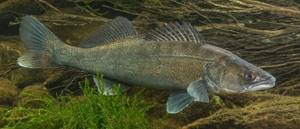
Another unusual structural feature is a rare fish organ called the lateral line. It is a channel with sensitive nerve cells that determine the strength of the water flow and its direction. A fish that has completely lost its vision can survive thanks to its hypersensitive lateral line.
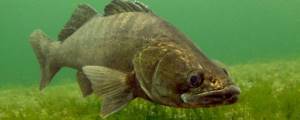
Lures
As already mentioned, a large number of specialized spinners are used for winter fishing. There are quite a lot of homemade options that can surprise those ignorant of fishing with their “originality.” In addition to spinners, a variety of volumetric baits are currently actively used: balancers, winter wobblers and their modifications. In some cases, large jigs or spinning equipment for silicone baits are used to feed “dead fish”. In the summer, many fishermen use baits designed specifically for catching pike perch and bersh: foam rubber and polyurethane fish; weighted streamers; multi-component baits made from tinsel and cambrics; spinners made of metal tubes, etc. Various jig attachments and equipment for them have proven to be the main baits for bersha. Some fairly large species may be equipped with additional leashes and hooks. Currently, most of these baits are made of silicone. The choice can be very varied and is directly related to fishing conditions. For fly fishing, large, voluminous streamers are used; in the case of fishing in pits, heavily weighted streamers are used, using fast-sinking undergrowth.
Catching
Fishing for bersh can be very interesting both in open water and from ice. In open water, this predator is usually caught using a spinning rod. The most exciting and challenging fishing is using spinning tackle. If we are talking about fishing on a deep river with a moderate current, then the fisherman will need quite powerful gear that allows long-distance casting of heavy bait. Such gear consists of several elements:
- spinning rod 2.4–2.7 m long with a test range of 30–80 g;
- spinning reel series 3000–3500;
- braided cord with a diameter of 0.10–0.12 mm;
- guitar string leash.
Since fishing is predominantly carried out using the jig method, which requires increased sensitivity of the gear, the spinning rod must have a fast or ultra-fast action, ensuring the registration of every touch of the fish to the bait. In addition, the combination of a rigid rod and a braided cord will not only allow you to feel the bites of a predator well, but will also make it possible to determine the nature of the structure of the bottom relief.
If the angler fishes from a boat, then particularly long casts are not required. For fishing from a watercraft, a spinning rod with a length of 2.4 m is sufficient. A longer rod is useful when it comes to coastal fishing and the fisherman needs to cast over a long distance. Since fairly heavy baits are used for fishing on a deep-sea river, the upper limit of the test range of the rod should not be less than 80 g.
A “braid” with a thickness of 0.10–0.12 cm is wound onto an inertia-free reel. The braided cord has an elongation coefficient close to zero and makes the tackle more sensitive. In addition, a thin cord is less susceptible to drift, which also increases the information content of the gear.
Bersh is not able to bite through a braided line, but when bottom fishing you must use a metal leash. This is due to the fact that the part of the “braid” closest to the bait constantly rubs against the bottom soil and wears out quickly. A metal leash will help prevent the cord from fraying and increase the reliability of the gear. The experience of many spinning anglers proves that the presence of a metal leash in the equipment does not have a negative effect on the bite of the bersh.
Since the bersh's mouth is relatively small, medium-sized baits 6–9 cm long are better suited for catching it. To catch this predator, it is better to use:
- vibrotails;
- twisters;
- small jigs;
- composite baits made of polyurethane foam.
The color of silicone baits is selected taking into account the characteristics of the reservoir and the activity of the predator. If dark and natural colors show good results in clear water, then yellow and carrot colors will work better in cloudy water.
For fishing in the reservoir, you can use more delicate gear, which is due to the lack of current and the use of bait weighing no more than 40 grams. The type and size of baits for fishing in still water are no different from those used for fishing on the river. The main difference is the weight of the jig head mounted on the bait.
During the period of open water, you should look for bersha at a depth of 7–12 m. During the daytime, this predator bites in places with sharp changes in depth. In the morning and evening hours, bersh can be caught on flat plateaus, which are located not far from the main channel or a deep hole, where it goes out to hunt for fry.
Bersha can be successfully caught from ice in winter. For river fishing, gear consisting of the following elements is most often used:
- winter fishing rod with an elastic nod;
- fishing line about 0.22 mm thick;
- cargo weighing 30–50 g;
- leash with hook.
This tackle is easy to manufacture, so even a novice angler can easily assemble it. About 20 m of fishing line with a diameter of 0.20–0.24 mm is wound on a winter fishing rod. A sinker weighing about 40 grams is tied to the end of the main monofilament. A small loop is formed 30 cm above the tied load, to which the leash will subsequently be attached. The length of the leash should be at least 80 cm, which will ensure the nozzle actively plays in the water flow. A single hook No. 4–3 is attached to the leash.
An angler usually uses several of these fishing rods at once, placing them at some distance from each other. The fish bite is clearly visible by the sharp bending of the guard. It is better to attach frozen sprat to the hook of such equipment, which the bersch really likes and is its usual food.
At the reservoir, bersh are caught using spoons and balance beams 6–8 cm long. To catch it, use a fishing rod equipped with a reel and a hard whip, which allows you to clearly cut through the bony mouth of the predator. Bersh bites on artificial winter baits can be very aggressive and are well transmitted to the hand, so the fishing rod does not need to be equipped with a nod.
In winter, you should look for bersh on the river near the fairway, where the depths are 8–14 m. On the reservoir, the predator prefers to stand in deep holes, but hunts in the adjacent reaches with depths of 6–8 m. In winter fishing for predators on the reservoir, the main bet is should be done to actively search for fish.
Knowing the main differences between bersh and pike perch, an angler will always be able to distinguish these species and quickly select the most suitable bait. Despite the fact that bersh is not as impressive in size as pike perch, catching it can be no less interesting.
Food and spawning time
It begins to spawn later than ordinary pike perch. In the middle reaches of the Volga, the beginning of spawning coincides with the breeding season of bream, approximately at the beginning of April. In warmer regions, in the Volga delta, in the Black Sea basin, bersh go to spawn from mid-March.
Part of the population spawns as semi-anadromous fish, rising into rivers from marine areas. For spawning, bershis choose protected places without strong currents. For spawning, the female prefers a sandy or pebble bottom. The eggs are numerous and small. Parental instinct is undeveloped.
The larvae hatch after 5-6 days, remaining motionless for the first time. After 2-3 days, they begin to swim, feeding on small aquatic inhabitants, and then switch to a diet of invertebrates. Reaching a size of 10 cm, the young gradually switch to a predatory lifestyle, hunting fry of other breeds.
Adults behave like completely predatory fish. Small concentrations of bershas drive schools of fish into places convenient for hunting. Solitary representatives more often use the ambush method of fishing, hiding under snags while waiting for prey. The peculiarities of the Volga and common pike perch lie in the choice of prey: predators have a narrow and not very plastic pharynx. This structure of the oral apparatus allows them to eat only small fish (minnows, roaches, fry of other species).
Let's consider whether black spots on fish are harmful to humans.
Often, parasites, while in the victim’s body, poison it with the products of their vital activity. As for cercariae, they do not emit substances harmful to humans. And you can eat such fish, BUT! The fish is contaminated and still poses a danger to humans. If the technology for preparing fish is violated, you can become infected with a helminthic infection.
However, if you follow the technology for preparing fish, then infection with parasites is reduced to zero.
Tip : If you are preparing fish soup, you need to cook until the fish is completely cooked. If you fry, there should be a crispy yellow crust on the surface of the fish. And you need to pickle it strictly according to the instructions (freeze it for at least a month, keep it in salt for at least 7 days). Raw or lightly salted fish should not be eaten.
All these tips exclude the viability of various kinds of parasites.
But still, some fishermen advise that caught sick fish should be disposed of and not eaten in order to protect themselves and their families from infection with helminthic infections.
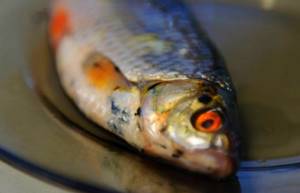
Thank you all for your attention! No tail, no scales, fishermen!
Did you like the article? Subscribe to the channel to stay up to date with the most interesting materials
Bersh and pike perch, the differences between which can be noticed by an experienced fisherman, are considered related breeds. They can even live in the same body of water. Sometimes they express the opinion that bersh is a mixture of pike perch and perch, but ichthyologists simply classify the fish as different species of the same genus.

